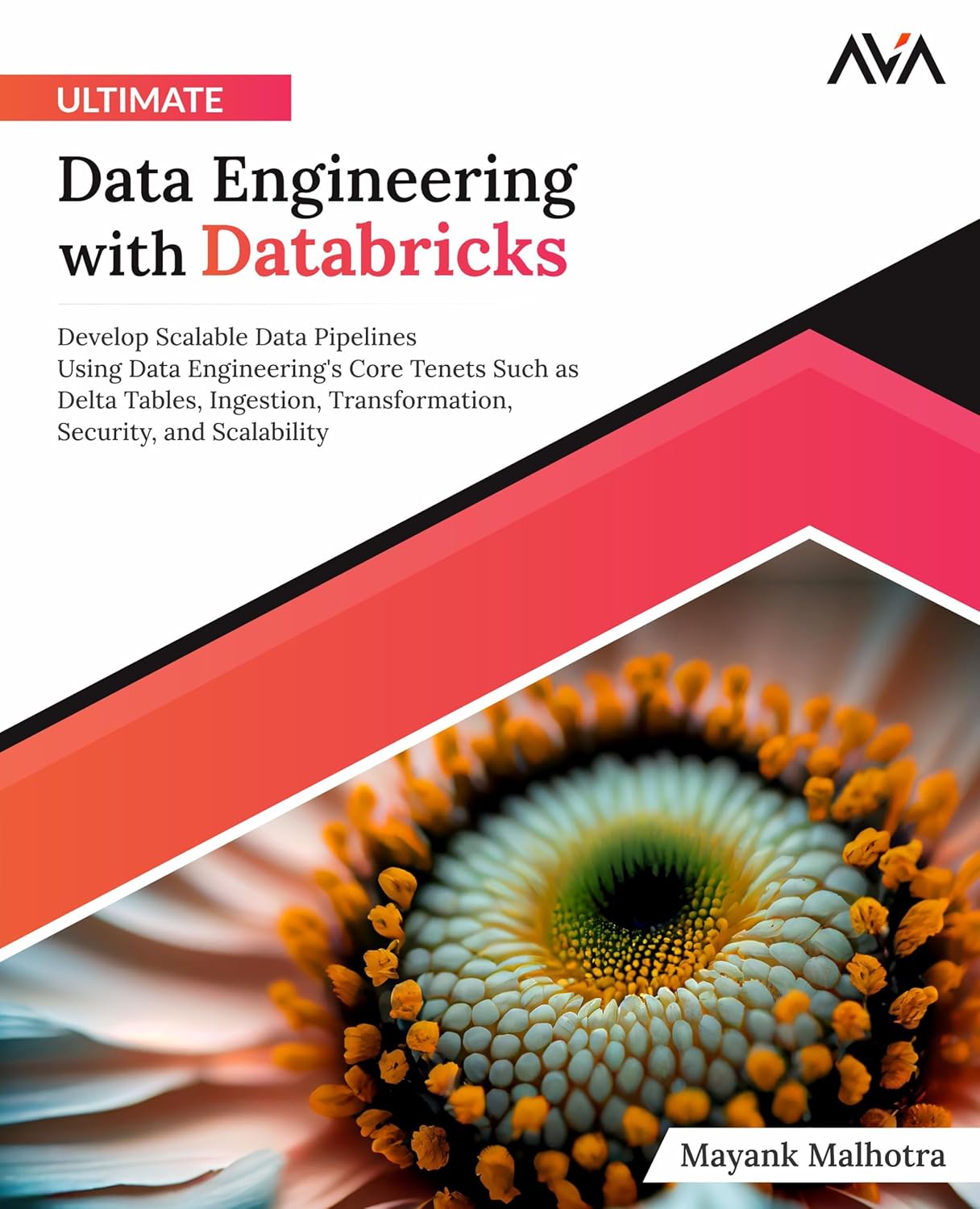Price: $37.95
(as of Dec 14,2024 11:32:00 UTC – Details)
From the Publisher
Know more about the book




Ultimate Data Engineering with Databricks Navigating Databricks with Ease for Unparalleled Data Engineering Insights.
In an age where data is the new currency, mastering the art of data engineering has become more crucial than ever. This book, Ultimate Data Engineering with Databricks, is a culmination of my experiences and learnings, designed to guide you through the intricacies of data engineering in the modern cloud environment.
The journey begins with Chapter 1, Fundamentals of Data Engineering with Databricks, providing a solid foundation for those new to the field or looking to strengthen their core understanding. Following this, Chapter 2, Mastering Delta Tables in Databricks, dives into the specifics of handling data at scale, a skill pivotal in today’s data-intensive world.
As you progress through the chapters, from Chapter 3, Data Ingestion and Extraction, to Chapter 4, Data Transformation and ETL Processes, the focus shifts to the practical aspects of managing and manipulating data.
WHAT WILL YOU LEARN
● Acquire proficiency in Databricks fundamentals, enabling the construction of efficient data pipelines.
● Design and implement high-performance data solutions for scalability.
● Apply essential best practices for ensuring data integrity in pipelines.
● Explore advanced Databricks features for tackling complex data tasks.
● Learn to optimize data pipelines for streamlined workflows.
WHO IS THIS BOOK FOR?
This book caters to a diverse audience, including data engineers, data architects, BI analysts, data scientists, and technology enthusiasts. Suitable for both professionals and students, the book appeals to those eager to master Databricks and stay at the forefront of data engineering trends.
KEY FEATURES Navigate Databricks with a seamless progression from fundamental principles to advanced engineering techniques. Gain hands-on experience with real-world examples, ensuring immediate relevance and practicality. Discover expert insights and best practices for refining your data engineering skills and achieving superior results with Databricks.


About the Author
Mayank Malhotra’s journey in the tech world began as a big data engineer, quickly evolving into a versatile data engineering His extensive experience spans various cloud platforms such as AWS, Azure, and Databricks, as well as On-Prem Infrastructure, showcasing his adaptability and depth of knowledge. A BTech graduate, Mayank’s academic foundation laid the groundwork for his successful career.
In the realm of data engineering, Mayank has tackled a diverse range of projects, from data migration and modeling to data transformation and quality validation. His ability to navigate complex data landscapes has not only honed his skills but also made him a sought-after expert in the field. One of his key beliefs, “Be the senior you needed as a junior,” reflects his passion for mentoring. He thrives on guiding others, sharing insights, and discussing new design approaches in data engineering, making him a valuable mentor and leader.


Meet the Technical Reviewer
Nawaz Abbas started his career with Accenture 12 years ago. His journey in the field of Information Technology has given him a chance to explore multiple domains such as Banking, Security, and Consumer sectors, with exposure to various technologies in the field of Big Data and Analytics.
He likes to be involved in building and designing data pipelines using various Big Data Technologies like PySpark, Databricks, Scala, Java, Kafka, Hive, Airflow, and more. More recently, he has taken on the roles ofa Technical Lead and/or Big Data Engineer. He has worked on various AWS components, including AWS Lambda, SNS, Athena, S3, EC2, Load Balancer, Elastic Beanstalk, ASG, and more.
As an avid reader, Nawaz likes to remain close to newer technologies and stay connected to the latest industry trends. In his free time, you might find him spending time with his family, traveling, watching soccer, playing cricket, or participating in CSR events.
Copyright Disclaimer
Copyright at 2024, Orange Education Pvt Ltd, AVA
All rights reserved. No part of this book may be reproduced, stored in a retrieval system, or transmitted in any form or by any means, without the prior written permission of the publisher, except in the case of brief quotations embedded in critical articles or reviews. Every effort has been made in the preparation of this book to ensure the accuracy of the information presented. However, the information contained in this book is sold without convincing, either express or implied.
Neither the author nor Orange Education Pvt Ltd. or its dealers and distributors, will be held liable for any damages caused or alleged to have been caused directly or indirectly by this book.
Orange Education Pvt Ltd. has endeavored to provide brand information about all of the companies and products mentioned in this book by the appropriate use of capital. However, Orange Education Pvt Ltd. cannot surety the accuracy of this information. The use of general descriptive names, registered names, trademarks, service marks, etc. in this publication does not imply, even in the absence of a specific statement, that such names are exempt from the relevant protective laws and regulations and therefore free for general use.
First published: February 2024
Published by: Orange Education Pvt Ltd, AVA
Publisher : Orange Education Pvt Ltd (February 15, 2024)
Language : English
Paperback : 267 pages
ISBN-10 : 8196994788
ISBN-13 : 978-8196994785
Item Weight : 1.03 pounds
Dimensions : 7.5 x 0.64 x 9.25 inches
Are you looking to take your data engineering skills to the next level? Look no further than “Ultimate Data Engineering with Databricks: Develop Scalable Data Pipelines Using Data Engineering’s Core Tenets Such as Delta Tables, Ingestion, Security, and Scalability.”
In this comprehensive guide, you will learn how to leverage Databricks, a unified analytics platform, to build scalable and efficient data pipelines. From understanding the fundamentals of data engineering to mastering advanced techniques such as Delta tables, ingestion, security, and scalability, this book covers everything you need to know to excel in the field of data engineering.
Whether you are a beginner looking to get started with data engineering or an experienced professional looking to enhance your skills, “Ultimate Data Engineering with Databricks” has something for everyone. So why wait? Dive into the world of data engineering and unlock the true potential of your data with this essential guide.
#Ultimate #Data #Engineering #Databricks #Develop #Scalable #Data #Pipelines #Data #Engineerings #Core #Tenets #Delta #Tables #Ingestion #Security #Scalability #English #Edition











